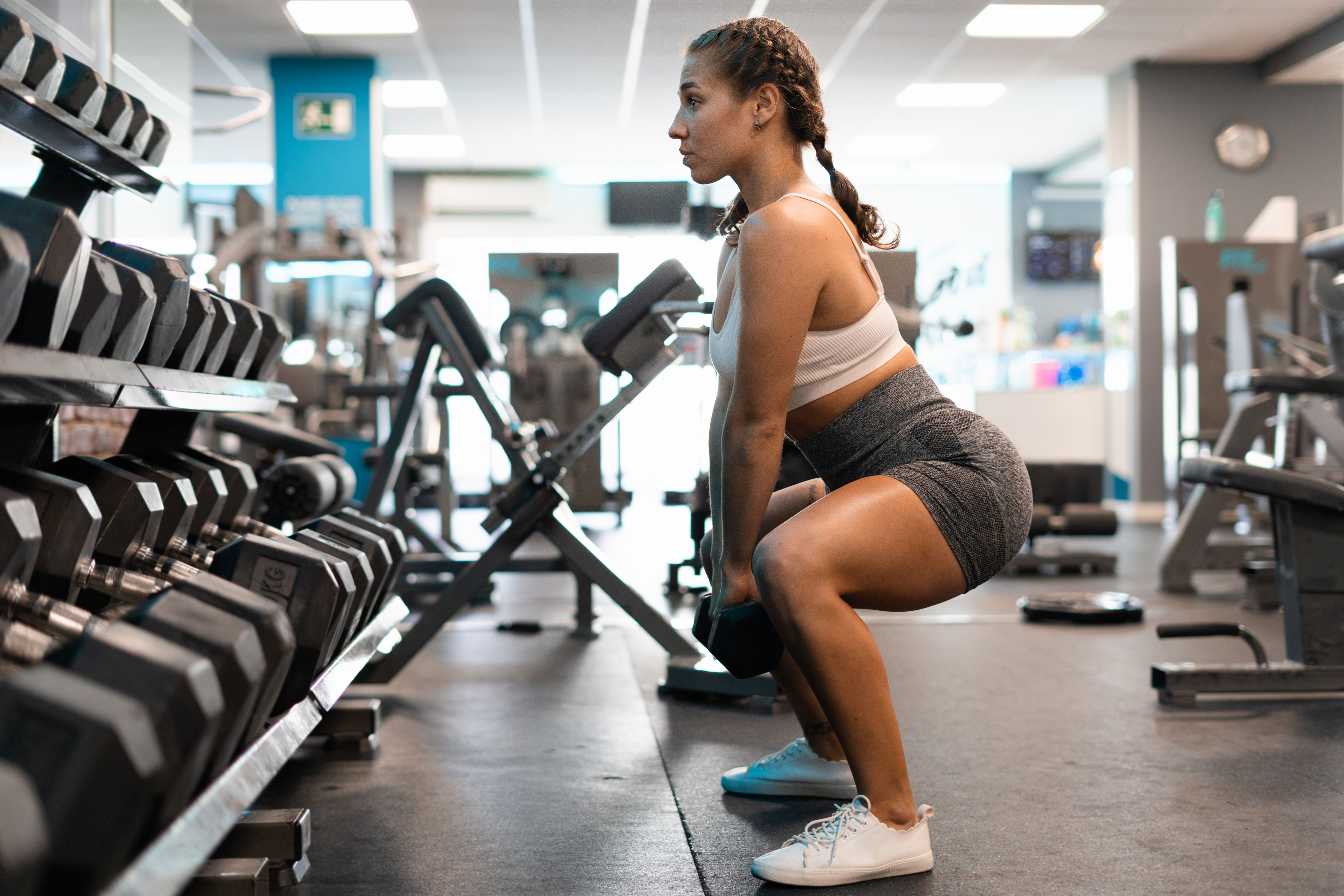
Alberto Case/Moment via Getty Images
What Is the “Butt Wink” and Do You Really Need to Fix It?
Experts decode what the squat term means and what you need to know.
By Lauren Mazzo•
What Exactly Is a Butt Wink?
What Causes the Butt Wink During Squat Exercises
How Does Butt Wink Affect Your Squats?
How to Fix and Prevent Butt Wink During Squats
Exercises For Better Squat Form
Ever heard of a butt wink? Perhaps you’ve seen it on GymTok or mentioned in the depths of fitness Reddit. It’s the name for a very slight movement that happens with your pelvis while squatting, and though the phrase itself sounds fun, it may not be a great thing to have showing up in your leg day workouts.
Depending on how heavy you’re lifting or how low you’re dropping, a butt wink could be NBD or something to worry about. Even more confusing? It depends on who you ask; the buzzy concept is somewhat divisive even among experts in the fitness community.
So should you worry about your butt wink, or let it be? And can you actually do anything about it? We break down the need-to-know details about butt winks during squats.
What Exactly Is a Butt Wink?
“A butt wink happens at the bottom of a squat when your pelvis tucks underneath you, causing your lower back to go into flexion or round,” explains Peloton instructor Jess Sims.
If you watch someone squat until their thighs are parallel to the floor—or past that point—you may see their tailbone suddenly round toward the floor, tucking their butt under and pulling their lower spine out of a neutral position and into a posterior tilt, explains Schuyler Archambault, physical therapist and owner of Arch Physical Therapy and Fitness. Then, when the person starts to push out of the bottom of the squat, their hips will typically untuck and return to the position they were in before.
It’s called a butt wink because it typically lasts only a moment, and it sort of looks like someone’s butt is winking as their tailbone tilts down and then back up again.
What Causes the Butt Wink During Squat Exercises
Butt winks can happen for a few different reasons, including “lack of mobility in the ankles and/or hips, a weak core that doesn't support your back staying straight, or improper squatting technique,” Jess explains. Here’s how to spot what might be going on.
Lack of hip mobility: If you have a butt wink happening at the end range of a deep squat, you likely have decreased mobility of your hips, Archambault says. It may also be a result of your anatomy; not everyone will be able to perform a full squat while maintaining a neutral spine.
Lack of ankle mobility: If you don’t have adequate ankle mobility—specifically, ankle dorsiflexion, the act of bringing the tops of your feet and shins closer together—you may find you’re not able to keep your spine tall when squatting. “If your heels lift when you squat, you're overcompensating for poorly moving ankles,” Jess says.
Lack of core stability: If a butt wink is happening above the point in your squat where your thighs are parallel to the floor, it’s likely a lumbopelvic control issue. “Lumbopelvic control is the ability to control the spine and pelvic movement together,” Archambault explains. Issues with lumbopelvic control mean you likely aren’t able to properly engage your deep core muscles due to the positioning of your spine and pelvis, she says.
Improper squat form or setup: This one may be tough to spot yourself, especially if you think you’re doing squats correctly. “Take the time to do bodyweight squats and check your form in the mirror to make sure your feet are about shoulder-width apart, toes out to 11 and 1. “Push your hips back as you descend (paying particular attention to your lower back not rounding or tucking under) and using your exhale to bring you back to standing position,” Jess says. She suggests checking your form above parallel, at parallel, and below parallel. You can also tap an exercise professional to check your form or take a video of yourself squatting and try to see where you might be going wrong. You may be able to fix a butt wink by simply adjusting your squatting stance (but more on that, below).
How Does Butt Wink Affect Your Squats?
Around the internet, butt winks are generally referred to as a red-flag mistake you need to fix, stat—but that’s not always the case. You could squat for years with a butt wink and not experience any repercussions, and it may be more or less impossible to avoid it at the very bottom of a deep squat, depending on your anatomy. If you’re hanging out down there on occasion (think: during a yogi squat, or when doing warm-up drills before a run), a butt wink likely isn’t anything to worry about; however, if you’re lifting heavy (think: front or back squatting with loaded barbells) with a butt wink, you could put yourself at risk of injury, Archambault says.
Can Butt Wink Lead to Back Pain?
Potentially. Because a butt wink causes your lower back to go into flexion, if you’re lifting a lot of weight, you can put a lot of stress on your lower back, Jess says. However, if you’re not squatting heavy, it likely won’t cause any issues, Archambault says. “If you load your squat very very heavy and are having a butt wink, it could become painful over time. But the average person lifting with a butt wink will likely not have back pain from it.”
Should You Worry About the Butt Wink?
It depends, Archambault says. If it happens at the end range of a deep squat, and you don’t regularly go that low while lifting heavy weights, it’s not likely to cause issues, she explains. However, if you notice a butt wink higher up in the movement and/or you’re heavily loading your squats, then it could potentially lead to injury, she says. Similarly, if a butt wink is suddenly showing up in your squats or you’re experiencing any back pain, it may be something to address.
How to Fix and Prevent Butt Wink During Squats
To fix a butt wink or prevent it from continuing to happen, you need to get to the root of the problem, Jess says. The best solution depends on what problem is causing your butt wink in the first place. These three strategies can help you pinpoint the problem and tweak your squats so they’re wink-less.
Switch Your Stance
This is the easiest fix, and it can make a significant difference in the movement of the lumbar spine during squats, research shows. Try widening your stance to take the stress off the hips, Archambault says, and point your toes out slightly versus pointing straight ahead. Squatting with your feet too close together can cause a butt wink as it makes it harder for you to maintain a neutral spine as you descend. You may need to play with it; the exact right squat setup for you will depend on your personal hip anatomy.
Elevate Your Heels
If you think the cause of your butt wink is a lack of hip or ankle mobility, try squatting with your heels elevated a few inches (for example, on top of weight plates). (Wearing a pair of weightlifting sneakers with an elevated heel can also help.) This reduces the amount your ankle and hip joints need to flex in the deepest part of your squat, Archambault says, which can help you maintain a neutral spine.
Don’t Squat So Low
If a lack of hip mobility is causing your butt wink, “you may want to squat to just parallel instead of below parallel (aka no more ‘ass to grass’),” Jess says. “Keeping your squats above parallel decreases the likelihood of you having a butt wink but still allow you to squat.”
The good news is that Archambault says most people don’t need to go below parallel anyway. “For the average population, squatting to get your thighs parallel to the floor is a good range,” she says. Moreover, research confirms that parallel squats seem to activate the glutes, hamstrings, and quads as much as full-depth squats do.
Go Back to Basics
If your back arches significantly during squats or you’re unable to maintain a neutral spine until hitting parallel in your squat, you may need to work on your lumbopelvic control and core stability. To do so, back off of weighted squats and go back to the basics: Work on hip and lower back control while doing unweighted squats, focusing on engaging your core and keeping your back and pelvis in a neutral position, Archambault says.
Exercises For Better Squat Form
Whether or not you have a butt wink—and whether or not you’re worried about it—these drills can help ensure you’re mobile, strong, and squatting with proper form. As you go through all of these drills, make sure you work slowly and controlled, Archambault says. And if you’re having any pain or are concerned about your butt wink, seek out an exercise pro like a physical therapist for help.
Mobility Drills
If you’re part of the tight-ankle crew, try doing ankle mobility exercises to open up some space in your lower legs, which will allow you to squat deeper. To increase hip mobility, try exercises like seated 90/90 hip rotations and hip CARs (controlled articular rotations), Archambault says.

Core Strength Exercises
To build core strength, do supine heel taps and dead bug progressions. “Work on not only the strength but also the muscular endurance (holding the positions),” Archambault says. “Once you’ve mastered moves with your back on the floor, progress to exercises like planks, and side planks, and incorporate [this strength] into your squats.”
Counterbalance Squats
Finally, work on deep bodyweight squats, Archambault says. Work on maintaining control of your hips and lower back, with your pelvis in a neutral position, she says. “Once you’re ready to add weight, hold the weight out as a counterbalance prior to going back to barbell or goblet squats.” That is, perform a squat while holding a weight out at arm’s length; research shows this type of squat can help you develop a more efficient movement pattern by shifting the way you distribute your weight.
Here’s how to do counterbalance squats:
Start standing with your feet shoulder-width apart and your toes pointing slightly out (or in whatever squat stance you’ve learned works best for you). Hold a light weight in both hands in front of your chest.
With your core engaged, slowly lower into a squat until your thighs are parallel to the floor. While lowering, simultaneously press the weight forward until your arms are fully extended.
Hold at the bottom for one count, then press into both feet to stand, bringing the weight in toward your chest as you do. That’s one rep.
Recommended
Peloton App
Access thousands of classes with no equipment needed.
This content is for informational and educational purposes only and does not constitute individualized advice. It is not intended to replace professional medical evaluation, diagnosis, or treatment. Seek the advice of your physician for questions you may have regarding your health or a medical condition. If you are having a medical emergency, call your physician or 911 immediately.
This content is for informational and educational purposes only and does not constitute individualized advice. It is not intended to replace professional medical evaluation, diagnosis, or treatment. Seek the advice of your physician for questions you may have regarding your health or a medical condition. If you are having a medical emergency, call your physician or 911 immediately.
Level up your inbox.
Subscribe for a weekly dose of fitness, plus the latest promos, launches, and events.
By providing your email address, you agree to receive marketing communications from Peloton.
For more about how we use your information, see our Privacy Policy.






